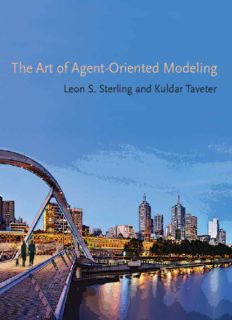Table Of Content(cid:53)(cid:73)(cid:70)(cid:1)(cid:34)(cid:83)(cid:85)(cid:1)(cid:80)(cid:71)(cid:1)(cid:34)(cid:72)(cid:70)(cid:79)(cid:85)(cid:14)(cid:48)(cid:83)(cid:74)(cid:70)(cid:79)(cid:85)(cid:70)(cid:69)(cid:1)(cid:46)(cid:80)(cid:69)(cid:70)(cid:77)(cid:74)(cid:79)(cid:72)
(cid:45)(cid:70)(cid:80)(cid:79)(cid:1)(cid:52)(cid:15)(cid:1)(cid:52)(cid:85)(cid:70)(cid:83)(cid:77)(cid:74)(cid:79)(cid:72)(cid:1)(cid:66)(cid:79)(cid:69)(cid:1)(cid:44)(cid:86)(cid:77)(cid:69)(cid:66)(cid:83)(cid:1)(cid:53)(cid:66)(cid:87)(cid:70)(cid:85)(cid:70)(cid:83)
The Art of Agent-Oriented Modeling
Intelligent Robotics and Autonomous Agents
Edited by Ronald C. Arkin
Dorigo, Marco,and Marco Colombetti, Robot Shaping: An Experiment inBehavior
Engineering
Arkin, RonaldC.,Behavior-BasedRobotics
Stone, Peter, Layered LearninginMultiagent Systems: A Winning Approach to
Robotic Soccer
Wooldridge,Michael, Reasoning aboutRational Agents
Murphy, Robin R.,An Introduction to AIRobotics
Mason, Matthew T., Mechanics ofRobotic Manipulation
Kraus,Sarit, StrategicNegotiation in Multiagent Environments
Nolfi, Stefano,andDarioFloreano,Evolutionary Robotics: The Biology,
Intelligence,and Technology of Self-Organizing Machines
Siegwart, Roland, and Illah R. Nourbakhsh, Introduction toAutonomous Mobile
Robots
Breazeal, Cynthia L., Designing SociableRobots
Bekey, George A., Autonomous Robots: From Biological Inspiration to
Implementation and Control
Choset, Howie,KevinM.Lynch,Seth Hutchinson,George Kantor,Wolfram
Burgard, LydiaE. Kavraki, and Sebastian Thrun, Principles ofRobot Motion:
Theory,Algorithms, andImplementations
Thrun,Sebastian, Wolfram Burgard, and Dieter Fox, Probabilistic Robotics
Mataric, Maja J.,The Robotics Primer
Wellman, Michael P.,Amy Greenwald, and Peter Stone, Autonomous Bidding
Agents: Strategiesand Lessonsfrom theTradingAgent Competition
Floreano, Dario, and Claudio Mattiussi, Bio-Inspired Artificial Intelligence:
Theories, Methods, and Technologies
Sterling, Leon S., and Kuldar Taveter, The Art of Agent-Oriented Modeling
The Art of Agent-Oriented Modeling
Leon Sterling and Kuldar Taveter
The MIT Press
Cambridge, Massachusetts
London,England
62009MassachusettsInstituteofTechnology
Allrightsreserved.Nopartofthisbookmaybereproducedinanyformbyanyelectronicormechanical
means (including photocopying, recording, or information storage and retrieval) without permission in
writingfromthepublisher.
Forinformationaboutspecialquantitydiscounts,[email protected].
ThisbookwassetinTimesNewRomanon3B2byAscoTypesetters,HongKong.
PrintedandboundintheUnitedStatesofAmerica.
LibraryofCongressCataloging-in-PublicationData
Sterling,Leon.
Theartofagent-orientedmodeling/LeonS.SterlingandKuldarTaveter.
p. cm.—(Intelligentroboticsandautonomousagentsseries)
Includesbibliographicalreferencesandindex.
ISBN978-0-262-01311-6(hardcover:alk.paper) 1.Intelligentagents(Computersoftware) 2.Computer
software—Development. I.Taveter,Kuldar. II.Title.
QA76.76.I58S757 2009
006.3—dc22 2008044231
10 9 8 7 6 5 4 3 2 1
To Miriam, Danya, Sara,and Emily
To Siiri, Eliise, and Sanne
Contents
Foreword xi
Preface xiii
Acknowledgments xvii
I MODELS 1
1 Introduction 3
1.1 Building Software in aComplex, Changing World 4
1.2 What Is an Agent? 7
1.3 From Individual Agents to MultiagentSystems 10
1.4 What Is Modeling? 14
1.5 Systems Engineering 15
1.6 EmergentBehavior 18
1.7 AQuick History of Programming Paradigms 20
1.8 Background 23
Exercisesfor Chapter 1 24
2 Concepts 27
2.1 The Conceptual Space 27
2.2 Roles, Goals, and Organizations 28
2.3 Agents and Activities 35
2.4 Environment 41
2.5 Relationships betweenthe Layers 43
2.6 OntologicalFoundationsof the Conceptual Space 44
2.7 Background 56
Exercisesfor Chapter 2 59
viii Contents
3 Models 61
3.1 The Running Case Study 61
3.2 Goal Models and Motivational Scenarios 65
3.3 Role and Organization Models 71
3.4 DomainModels 76
3.5 Agent and Acquaintance Models 78
3.6 InteractionModels 82
3.7 Knowledge Models 89
3.8 Scenarios 94
3.9 Behavior Models 98
3.10 ServiceModels 105
3.11 Background 112
Exercises for Chapter 3 117
4 Quality 119
4.1 Considerationsof Quality 120
4.2 Performance 122
4.3 Safety 125
4.4 Security 132
4.5 Socially Oriented Quality Goals 136
4.6 Elaborating and Analyzing Quality Goals 138
4.7 Background 141
Exercises for Chapter 4 141
5 AgentProgramming Platformsand Languages 143
5.1 The BDI Agent Architecture and Execution Model 145
5.2 Jason 148
5.3 3APL 152
5.4 JACK 160
5.5 JADE 166
5.6 Background 173
6 Viewpoint Framework 177
6.1 Conceptual Frameworks 177
6.2 Model-Driven Architecture 183
6.3 The Viewpoint Framework 185
6.4 Background 187
Contents ix
II APPLICATIONS 189
7 Agent-Oriented Methodologies 191
7.1 AConference ManagementSystem 192
7.2 Gaia 194
7.3 MaSE 199
7.4 Tropos 206
7.5 Prometheus 211
7.6 ROADMAP and RAP/AOR 220
7.7 Background 234
8 Industry-Related Applications 239
8.1 Business-to-BusinessE-Commerce 239
8.2 Manufacturing 261
8.3 Background 278
9 Intelligent LifestyleApplications 281
9.1 IntelligentHomes 281
9.2 Secret Touch 297
9.3 Smart Music Player 304
9.4 Background 325
10 AnE-Learning Application 327
10.1 Supporting theTeaching of AlgorithmswithAnimations 327
10.2 Background 336
Glossary 339
List of Acronyms 347
References 351
Index 361
Description:Today, when computing is pervasive and deployed over a range of devices by a multiplicity of users, we need to develop computer software to interact with both the ever-increasing complexity of the technical world and the growing fluidity of social organizations. The Art of Agent-Oriented Modeling pr

